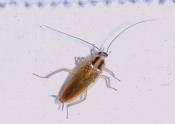
Since the inception of the Texas School IPM Law and Rules, school districts, IPM coordinators, pest management professionals and regulators have struggled with three words associated with IPM: program, policy, and plan. What are they and why are they important to the success of your program is what we will focus on in this issue of school pest news.
According to the School IPM Law adopted in 1991 and amended in 2001, 2007, and in 2009 each independent school district shall adopt an integrated pest management program that is outlined by the regulating agency (Texas Department of Agriculture/TDA). Within the School IPM rules, TDA requires school districts to have an IPM program. An IPM program is a set of related measures or activities with a long-term aim. The aim for schools is typically no pests inside the buildings and limited pesticide use in and around campuses. The IPM program recognizes that maintenance of a safe, clean, and healthful environment for student and staff is essential to learning.
The key components of an IPM program are:
- Pest Identification
- Prevention
- Recordkeeping
- Monitoring
- Notification
- Evaluation
- Education of staff
- Regulations and policies
- Written IPM plans with thresholds that trigger responses
If you review Rule §7.201, Responsibility of School Districts to Adopt an IPM Program you will notice that the Department of Agriculture outlines several key points of IPM in the written rules. These rules state that each school districts IPM program will have:
- school board approved IPM policy
- monitoring program
- use lower risk pesticides
- use of non-chemical management strategies
- system for keeping records
- education program to inform school district employees about their roles in the IPM program
- written guidelines that identify thresholds for when pest control actions are justified
If you compare the bullet items that describe what are the key components of an IPM program versus what TDA requires schools to have as part of their IPM program you will notice several similarities. And each bullet item is critical to a cohesive IPM program, but the next two “P’s” are critical for guiding the IPM program.
The next “P” in IPM is Policy – TDA and anyone recommending IPM will often mention having a policy statement. A policy is a course of action adopted or proposed by a government, party, business or individual. The School IPM Policy is written by the Texas Association of School Boards (TASB) and sent to public schools in TX. TASB has 100 percent membership among 1,023 Texas school districts and works with school administrators to ensure that you have copies of your School IPM policies.
Something we recommend at every one of our school IPM trainings and prior to any TDA inspection is to go find your district IPM policy. To do this open your favorite internet browser (Chrome, Explorer, Firefox, Safari, etc.) and in the search box type your district name and policy on line, the search should come up with a link to your district page. The webpage view should look like the image below. It will have your district name on the top (notice this example is Manor) and there are two search boxes. Go to the “policy code” search box and in that box type “CLB”.

Once you do the search you should have a page that looks like the image below. You should have a CLB local and legal in Word, PDF, and HTML – pick a version of the legal and local, open them, save to your computer and then print for your IPM notebook/files.

This District Policy is one of the most important documents for your IPM program. The CLB local is the locally approved school board policy for IPM. Within this document you will notice it states only licensed applicators can make pesticide applications on school property, this statement alone can help you explain to teachers and staff on why they can’t make pest control applications themselves. Secondly, this statement also refers to the full set of school IPM laws which is also referenced in CLB legal. With these two documents you the IPM Coordinator can use the documents to educate staff, teachers, and administrators about your IPM program. Having a clear and concise IPM policy helps everyone who is part of your organization understand their roles.
The third “P” is plan. Plans are detailed instructions on how key pests will be managed, with detailed monitoring plans with thresholds that determine when treatments are necessary. These plans have preferred tactics and strategies that are typically specific to the pest and contain prevention and management options that are essential to your area of the state. Plans are written or documented, but don’t need to be approved by a school board as they may need to be flexible enough to manage unexpected situations. Plans should have basic information about a given pest (fire ants, outdoor cockroaches, mice, weeds, etc.) and then preventative or routine maintenance to keep aware of these common pests you experience in your district. The plan should also have non-chemical and chemical controls as well. For some pests like ants and roaches you may have different thresholds depending on species and location, since kitchens are typically more critical than a warehouse, plans will vary by location.

One of plans you should have on hand is for German cockroaches since they tend to hitch rides in back packs.
One of the resources we offer through a collaborative effort of Extension Professionals across the country is IPM Action plans for twenty-four of the most common pests, along with a document on basic IPM practices that you could use with staff when you are training them about their role in the IPM program. You can find these management plans here – you can download and use with your IPM program.
The final item Texas Schools should consider is a written document like our “Sample Written IPM Program with thresholds” document that you can find on our website under the School IPM Coordinator Notebook page. This is a Word document so it will download in that format so that you can edit this document to suit YOUR districts needs. With 1,023 school districts in our state it is hard to customize everything, this document is designed to help you customize your IPM program. This is critical depending on where you are located and where your pest pressure comes from: nature, students, teachers, or staff. The written program that complements the IPM Policy and pest management plans can seek input from teachers, School Health Advisory Committee (SHAC) members, school board members and even administrative staff like risk management and the school nurse. Using the opportunity to update your written IPM program is also a great way to remind everyone in the district about your IPM program and ensure you are keeping students and staff safe from pests and pesticide use.
Finally, if you are unsure if you are ready for TDA to come visit your school IPM program; check out the school IPM compliance audit I developed it to help prepare for TDA visits. This two-page checklist allows you to review the items you would need to present to a TDA inspector when they visit for their routine inspection. For those who are not familiar with the Texas School IPM rules the Department of Ag is required to visit 20% of the schools each fiscal year, which allows for schools to be audited every five years provided they are following the rules. One of services is to assist schools with compliance assistance through site visits. If you are struggling with your IPM program call or email today.
Written By: Janet Hurley, ACE, MPA, Extension Program Specialist

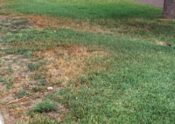



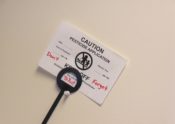




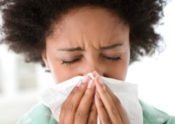
 The Centers for Disease Control and Prevention (CDC) reported January 11, 2019 that between 6.2 million and 7.3 million people have been sick with flu so far this season (since Oct. 1 2018), about half those people visited a doctor, and up to 83,500 people have been hospitalized in the U.S. There has been widespread flu in 31 states.
The Centers for Disease Control and Prevention (CDC) reported January 11, 2019 that between 6.2 million and 7.3 million people have been sick with flu so far this season (since Oct. 1 2018), about half those people visited a doctor, and up to 83,500 people have been hospitalized in the U.S. There has been widespread flu in 31 states. Flu comes every year, but the health impacts differ depending on when, and which strains start circulating. In recent years, flu related deaths have ranged from a low of about 3,000 to a high of about 49,000 people per year. Hospitalizations also range between 140,000 and 710,000 annually (CDC). During 2012-2013, about 45% of the U.S. population got vaccinated, helping to prevent an estimated 6.6 million flu-related illnesses.
Flu comes every year, but the health impacts differ depending on when, and which strains start circulating. In recent years, flu related deaths have ranged from a low of about 3,000 to a high of about 49,000 people per year. Hospitalizations also range between 140,000 and 710,000 annually (CDC). During 2012-2013, about 45% of the U.S. population got vaccinated, helping to prevent an estimated 6.6 million flu-related illnesses. So how can caregivers and facility managers maintain a healthy indoor environments, and limit the spread of the flu virus? Flu viruses spread from person to person mainly by droplets made when people with flu cough, sneeze, or talk. Less often, people might get the flu by touching a contaminated surface or object, and then infect themselves by touching their own mouth, eyes, or nose. Most healthy adults are capable of infecting other people 1 day before symptoms develop, and up to 7 days after becoming sick. Children may pass the virus for longer than 7 days. Symptoms start 1 to 4 days after the flu virus enters the body.
So how can caregivers and facility managers maintain a healthy indoor environments, and limit the spread of the flu virus? Flu viruses spread from person to person mainly by droplets made when people with flu cough, sneeze, or talk. Less often, people might get the flu by touching a contaminated surface or object, and then infect themselves by touching their own mouth, eyes, or nose. Most healthy adults are capable of infecting other people 1 day before symptoms develop, and up to 7 days after becoming sick. Children may pass the virus for longer than 7 days. Symptoms start 1 to 4 days after the flu virus enters the body. Here are five important things to know as you combat the flu virus.
Here are five important things to know as you combat the flu virus.






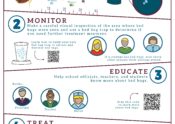
 Integrated pest management (IPM) is a process that requires cooperation among all school staff members, faculty and students and pest management professionals within a school district. IPM is a strategy of managing pests using multiple control tactics that provide the best control with the least cost and environmental impact. IPM is based on thorough knowledge of the pests and the technologies used to control them and can be performed by anyone with proper training. A good IPM program attempts to make schools less hospitable to pests by modifying the environment and by using the lowest impact pesticides necessary. Managing risks from pests and risks from the pesticides used to control them are top priorities under an IPM program.
Integrated pest management (IPM) is a process that requires cooperation among all school staff members, faculty and students and pest management professionals within a school district. IPM is a strategy of managing pests using multiple control tactics that provide the best control with the least cost and environmental impact. IPM is based on thorough knowledge of the pests and the technologies used to control them and can be performed by anyone with proper training. A good IPM program attempts to make schools less hospitable to pests by modifying the environment and by using the lowest impact pesticides necessary. Managing risks from pests and risks from the pesticides used to control them are top priorities under an IPM program. School Nurses: School nurses should be aware of the IPM Policy, IPM Plan, and pesticides on school property. Be familiar with the signs and symptoms of pesticide poisoning. Be aware of signs of pest exposure including head lice, fire ants, bed bugs, asthma, rabies and mosquito and tick-borne diseases present in the region. The nurse should be able to communicate with the IPM Coordinator about such concerns. A nurse should:
School Nurses: School nurses should be aware of the IPM Policy, IPM Plan, and pesticides on school property. Be familiar with the signs and symptoms of pesticide poisoning. Be aware of signs of pest exposure including head lice, fire ants, bed bugs, asthma, rabies and mosquito and tick-borne diseases present in the region. The nurse should be able to communicate with the IPM Coordinator about such concerns. A nurse should: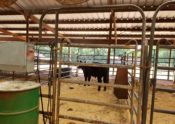



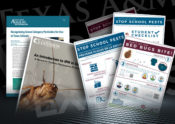



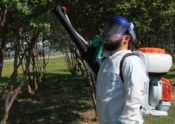



 .
.